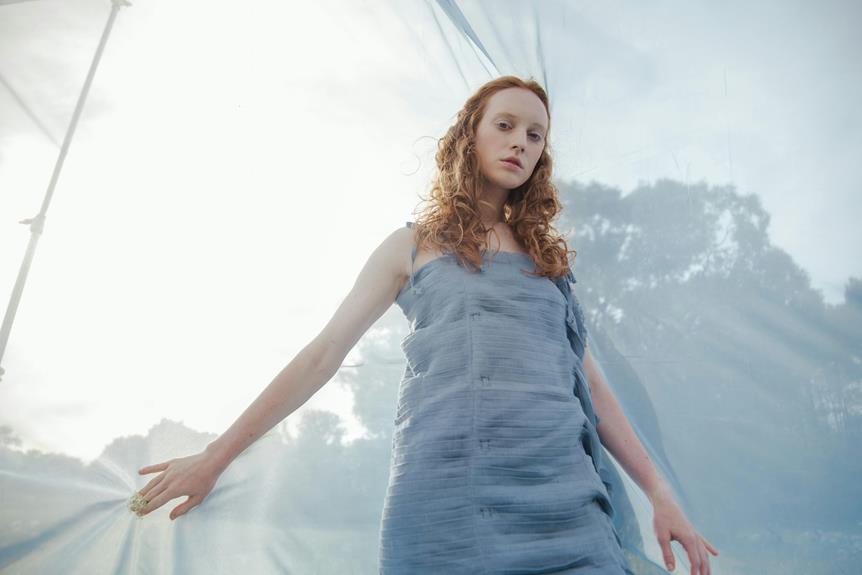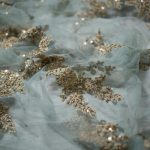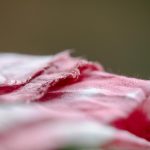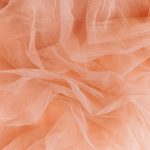When you're looking at gossamer and chiffon, you'll quickly notice they each offer distinct levels of transparency that can influence your fashion choices. Gossamer tends to provide a more ethereal, airy look due to its loosely woven structure, while chiffon presents a slightly denser appearance, allowing for modest layering. But how do these differences impact styling and wearability for various occasions? Understanding the nuances could change how you approach fabric selection—and might just open up a new realm of possibilities in your wardrobe.
Table of Contents
Overview of Gossamer
Gossamer is a lightweight, sheer fabric that's often utilized for its delicate appearance and translucent quality.
It typically consists of silk, nylon, or polyester, making it both soft and gentle to the touch. When you run your fingers across the surface, you can feel how delicate the threads are, creating a fabric that flows beautifully. You'll notice that gossamer drapes effortlessly, adding an ethereal quality to garments and decor alike.
One of the standout features of gossamer is its impressive translucency. When layered, it can create visual depth without being overly opaque. If you're considering it for a project, think about how it can enhance your design by allowing light to filter through.
In fashion, designers often use gossamer for overlays, dresses, and elegant shawls. In home decor, it's perfect for curtains or accents, creating a dreamy atmosphere.
Gossamer doesn't just shine in its beauty; it's also lightweight, making it a breathable choice in warm weather.
Remember that while it's stunning, it requires careful handling, as the delicate threads can snag easily.
Overview of Chiffon
Chiffon's unique fabric composition and weave give it a light, airy feel that's perfect for a variety of applications.
You'll notice its exceptional light transmission characteristics, which make it a popular choice in fashion.
Let's explore its common uses and see how chiffon stands out in the world of textiles.
Fabric Composition and Weave
Chiffon is crafted from lightweight fibers, typically made of silk, polyester, or nylon, which contribute to its delicate texture and renowned transparency. The fabric's weave is an essential aspect of its charm, creating an airy quality that makes it a favorite for dresses, blouses, and scarves.
When you consider chiffon, keep these key factors in mind:
- Fiber Composition: The choice between silk, polyester, or nylon impacts the fabric's quality, sheen, and cost. Silk chiffon exudes luxury, while polyester is more affordable and durable.
- Weave Structure: Chiffon's plain weave is what gives it that signature floatiness and transparency. This weave allows for light to pass through, enhancing its delicate appearance.
- Drape and Flow: Due to its lightweight nature, chiffon drapes beautifully. This makes it ideal for layered garments and flowing designs, which are perfect for achieving an ethereal look.
Understanding these elements helps you appreciate why chiffon is such a beloved fabric, particularly when you're searching for something that balances elegance with a light feel.
Light Transmission Characteristics
Understanding chiffon's lightweight nature leads you to appreciate its remarkable light transmission characteristics, which contribute to its ethereal appearance.
When you look at chiffon, you'll notice how light dances through the fabric, producing a soft, glowing effect. This ability to transmit light comes from its sheer and delicate weave, often made from silk or synthetic fibers like polyester.
Chiffon typically has a lower opacity than many other fabrics, allowing it to enhance the layers and textures in your outfits, creating visual interest without overwhelming the overall design. You might also observe that the color intensity of chiffon changes with the angle of light; certain hues appear richer in direct light while others take on a more subdued tone, which adds depth to your garments.
Its transparency can evoke a sense of delicacy, making chiffon an excellent choice when you want to achieve a romantic or whimsical aesthetic. However, it's essential to consider how layering or combining chiffon with other materials can further manipulate its light transmission, enhancing its visual appeal even more.
Common Uses in Fashion
This versatile fabric is a favorite among designers for creating flowing dresses, elegant blouses, and delicate scarves that enhance both everyday and formal attire. Chiffon's lightweight and sheer qualities make it an ideal choice for various fashion applications. You'll find this fabric used in several key items you'll appreciate:
- Evening Gowns: Chiffon adds a romantic touch to evening wear with its graceful movement and ability to drape beautifully, making it perfect for special occasions.
- Bridal Wear: Many designers favor chiffon for wedding dresses and veils, as its ethereal quality creates a dreamy, soft silhouette, allowing for stunning layers and details.
- Layers and Accents: Chiffon works excellently in layering, often paired with other fabrics to add texture and visual interest to outfits, be it in skirts or tops.
Key Characteristics of Gossamer
Gossamer is known for its incredibly light weight and delicate texture, making it perfect for layering in fashion. This ethereal fabric brings an airy feel to any outfit, allowing for breathability without compromising style. You'll appreciate its fine weave, which creates a subtle sheen that catches the eye. Gossamer is versatile; it can be used in everything from evening gowns to boleros, adding a romantic touch.
Here's a quick overview of gossamer's key characteristics:
| Characteristic | Description | Benefit |
|---|---|---|
| Weight | Extremely light | Perfect for layering without bulk |
| Texture | Soft and delicate | Adds elegance and a luxurious feel |
| Translucency | Semi-transparent | Enhances the look of layered outfits |
| Durability | Moderate | Requires gentle care but can last well |
When you choose gossamer, you're opting for a fabric that contributes to sophistication and lightness. Its ability to drape beautifully means it'll elevate your wardrobe, allowing you to express your unique style effortlessly.
Key Characteristics of Chiffon
Chiffon offers a lightweight, sheer quality that's perfect for creating flowy silhouettes and adding a romantic flair to any outfit. This delicate fabric is beloved in fashion for its unique characteristics, making it a versatile choice for various styles.
Here are key features that define chiffon:
- Sheerness: Chiffon's semi-transparent nature allows layers to play off one another beautifully, creating a sense of depth in your ensemble. You can use it for everything from airy blouses to elegant evening gowns.
- Softness: Made from silk or synthetic fibers, chiffon feels soft against the skin, providing comfort and breathability. Its gentle draping quality enhances your movement, making it ideal for dancewear and formal occasions.
- Durability: Despite its delicate appearance, chiffon is surprisingly strong when adequately cared for. Whether you're opting for machine washing or hand washing, it can withstand the test of time with proper maintenance.
With these characteristics in mind, you can confidently incorporate chiffon into your wardrobe, knowing it will add that necessary touch of elegance, whether it's for daytime activities or special events.
Transparency Comparison
When examining the level of transparency, both gossamer and chiffon offer unique qualities that can dramatically influence the overall appearance of an outfit.
Gossamer is known for its ethereal, almost ghostly transparency. It allows light to filter through effortlessly, creating a soft and airy feel. When you wear gossamer, you'll likely notice how this fabric can add a touch of whimsy and delicacy to your look.
On the other hand, chiffon features a slightly denser weave, which provides transparency but with a bit more structure. You may find that chiffon adds a bit of modesty while still showcasing your skin underneath, giving you the best of both worlds. It's a popular choice for layered looks, as its transparency still lets your outfit shine without revealing everything.
Factors Affecting Transparency
When you consider transparency in fabrics like gossamer and chiffon, several key factors come into play.
The weave structure significantly influences how light passes through each material, while the colors and dyes can either enhance or diminish transparency.
Understanding these elements helps you make an informed choice for your next garment or project.
Fabric Weave Structure
Various fabric weave structures significantly impact the transparency of materials like gossamer and chiffon. As you explore these fabrics, you'll notice that the way the threads are woven together affects how much light passes through.
Here are three key factors to consider:
- Loosely Woven vs. Tightly Woven: Loosely woven fabrics, like some gossamer, allow more light to filter through, creating a sheer effect. In contrast, tightly woven designs, often found in chiffon, tend to block more light, making them less transparent.
- Thread Thickness: The thickness of the individual threads also plays a role. Thinner threads generally produce a more transparent fabric, while thicker threads contribute to opacity. This can be particularly evident in heavy chiffons that boast sumptuous textures but less see-through quality.
- Yarn Construction: The type of yarn used can alter transparency as well. For instance, multi-fiber or blended yarns may create a richer, more opaque look compared to single-fiber gossamer, which excels in its transparency.
Color and Dyes
The color and dyes used in gossamer and chiffon significantly influence their transparency, as darker shades tend to absorb more light, making fabrics appear less sheer. When you choose a lighter color, whether it's a pastel or a bright hue, you're likely to enhance the fabric's transparency. This can be especially important if you're looking for that delicate, airy look commonly associated with gossamer and chiffon.
To better understand how specific colors affect these fabrics, check out the table below:
| Color | Transparency Impact |
|---|---|
| Light Pastel | Increases transparency |
| Medium Shades | Moderate transparency |
| Dark Shades | Decreases transparency |
As you can see, lighter colors allow more light to pass through, showcasing the sheerness inherent in both gossamer and chiffon. On the other hand, if you opt for darker colors, you'll create a more opaque look, which may not be ideal if you're aiming for that ethereal effect. Always consider your color choices when working with these fabrics to achieve the desired transparency!
Choosing the Right Fabric
Choosing the right fabric means considering both the occasion and the desired level of transparency. Gossamer and chiffon each have unique qualities that can enhance your outfit, but it's essential to match them with the right setting.
Here are three key factors to keep in mind:
- Occasion: For formal events, chiffon's elegant drape and slight sheen may be more suitable. On the other hand, gossamer's delicate and airy nature can create a whimsical, romantic look perfect for casual outings or garden parties.
- Season: Think about the season when selecting your fabric. Chiffon tends to be heavier and may offer more warmth, making it better for cooler months. Gossamer, being lighter, is ideal for summer attire or layers that need breathability.
- Layering: If you're layering, consider how each fabric interacts with others. Chiffon pairs nicely with heavier fabrics, while gossamer can add a light touch to already heavy garments.
Frequently Asked Questions
Can Gossamer Be Used for Formal Wear?
Yes, you can definitely use gossamer for formal wear. Its delicate texture adds an elegant touch, while the lightness makes it comfortable. Just ensure it's styled appropriately to suit the formality of the event.
Is Chiffon Suitable for All Seasons?
Chiffon's lightweight fabric makes it suitable for warmer weather, but its versatility allows for layering in cooler months. You can easily style it year-round, adapting it with jackets or heavier pieces when needed.
How Do I Care for Gossamer?
To care for gossamer, hand wash it in cool water with a gentle detergent. Avoid wringing and wash separately to prevent snagging. When air drying, lay it flat to maintain its delicate structure.
What Patterns Are Available in Chiffon?
You'll find a variety of patterns in chiffon, from floral and polka dots to stripes and abstract designs. These patterns can add a fun, stylish touch to your outfits, perfect for any occasion you're planning.
Can Gossamer Be Dyed Easily?
Yes, you can dye gossamer easily. Its lightweight nature absorbs color well, allowing for vibrant results. Just ensure you use the right dye and follow proper techniques for the best outcome on this delicate fabric.
- What Is Pochampally Ikat? a Journey to India’s Silk City - June 27, 2025
- What Is Pochampally Ikat? a Journey to India’s Silk City - June 27, 2025
- What Is Pochampally Ikat? a Journey to India’s Silk City - June 27, 2025







